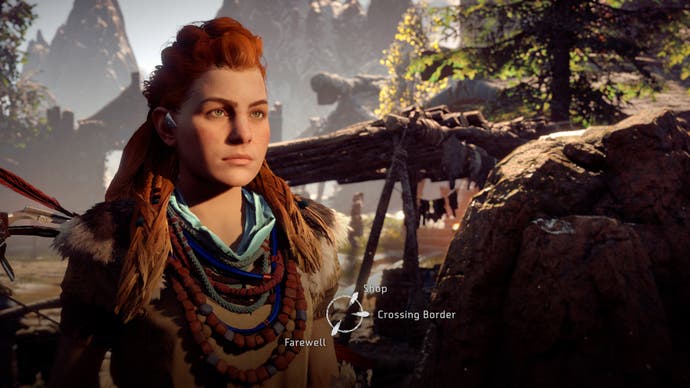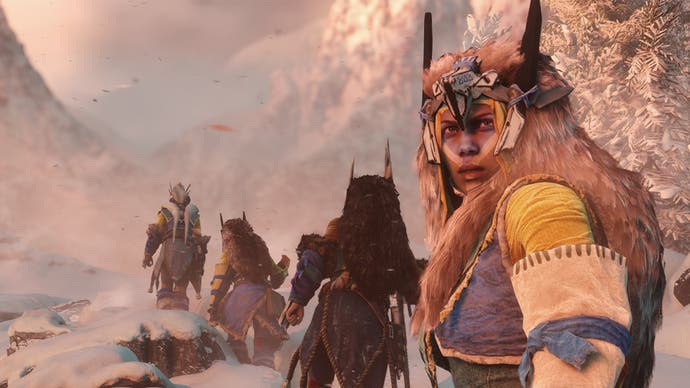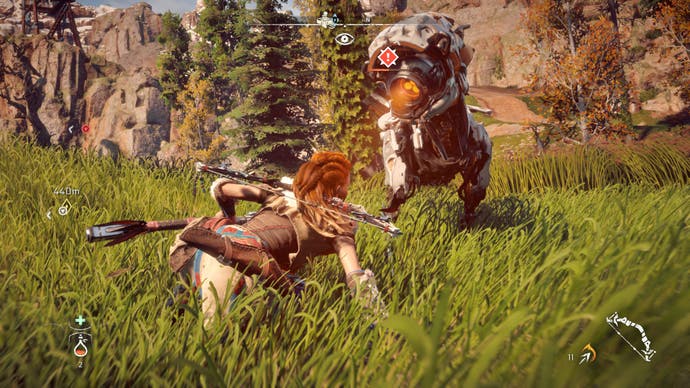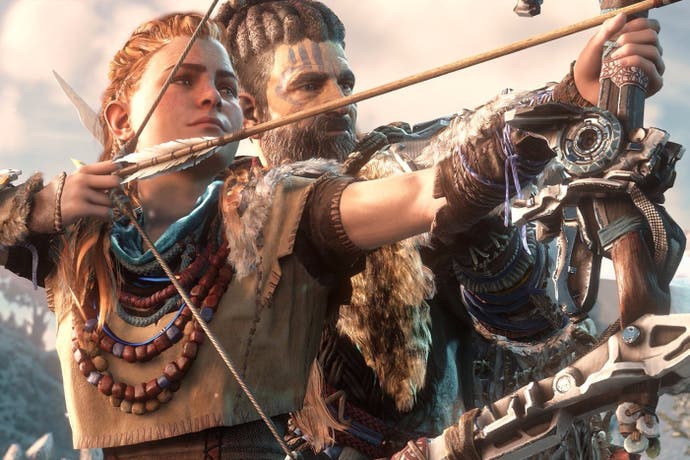Zoids not zombies: Horizon presents a brighter post-apocalypse
Aloy your fears.
Watching Sony's E3 2016 media briefing, you'd be forgiven for thinking all of the games made by the company were variations of Naughty Dog's post-apocalyptic masterpiece The Last of Us.
God of War now has a tighter, over-the-shoulder camera perspective, and as its debut trailer unfolded, some thought Sony Bend's Days Gone was The Last of Us 2 - until its title was revealed.
But not all Sony-made games are towing the grim dark post-apocalyptic party line.
Yes, Horizon, Guerrilla Games' big new PlayStation 4 exclusive, is set in a post-apocalyptic world, but it's a brighter, more vibrant one that trades tired zombies for Zoids-like machines. Set 1000 years after the fall, Horizon is post post-apocalyptic. Humans have reverted to a tribal existence, surviving under constant threat in little more than huts. How and why the world ended up this way is a mystery. The set-up and juxtaposition of science fiction and old world humanity reminds me of Cloud Atlas - specifically the bits with feral Hugh Grant.
But it was in the playing of Horizon at E3 that the game truly impressed me. Here's why.
It's gorgeous, and not just in a visual fidelity kind of way. There's a lot of detail packed into the open world, and a lot of that detail revolves around protagonist Aloy. Her flaming locks move realistically, and her animations blend wonderfully into each other. Then there's the odd flourish you spot in quieter moments: leave Aloy alone as snow falls and she reaches out to touch the snowflakes.
But the world is worth noting, too. The space handed over to me during my E3 hands-on was a lush green area with hills, a river and a mountain pass. It all felt alive, with swaying trees and dancing shrubbery. Horizon is quite the looker. Perhaps it's the best-looking open-world game yet.
Is it a true open world? The slice of Horizon's open-world available to me was a lush, snowy valley area, but Guerrilla promises a variety of environments, including deserts and jungles. Guerrilla reps Jan-Bart van Beek (studio art director) and David Ford (lead quest designer) told me there are a couple of initial gates to prevent the player from wandering too early into areas they shouldn't, but at a certain point in the story the world opens up, and it's up to players to test out its areas to see if they're too dangerous for them, in a similar fashion to The Witcher 3 and Grand Theft Auto 5. Largely speaking, Guerrilla says, you can go wherever you want whenever you want.
There are sidequests, too. In my demo, I saw blue diamonds hovering above NPC heads in Mother's Crown, Aloy's village. Each one of these represents a sidequest. I could have spoken with the NPCs, figured out what their problem was and picked up the sidequest to help them, if I fancied it.
Horizon has a hierarchy of quests. There's the main story and below that, tribe quests, which act on a national level (think of the tribes as having big picture problems that affect everyone in the tribe), and then below that are the more personal stories. For example, in Mother's Crown you'll meet an NPC who has something that's very important to them and so is urgent, but it doesn't affect the world.
Horizon doesn't have "big branching narratives", Guerrilla says. You can't change what happens with the choices you make. The dialogue wheel is used instead for learning more about the world. Of course, the world will change throughout the course of the quests, but this is tied to the overarching narrative.

That's the set-up, then. But how does Horizon feel to play? I'm happy to report it's responsive in a way Guerrilla's Killzone games aren't. Killzone feels sluggish, the result of an input delay that sometimes made it feel like you were trudging through mud. Horizon, which leans heavily on third-person action moves such as a roll dodge and melee attacks, feels much quicker to react to your commands. Aloy doesn't exactly dart around the game world as a Bayonetta or a Dante would, but she feels much more responsive than any of the characters in previous Guerrilla games, and that's a good thing.
There's a depth to the combat that's pretty interesting, too. The machines out in the wild present a decent challenge, which meant I had to think carefully about each engagement and employ patience with each fight.
Aloy wears a gadget that lets her scan an area, revealing information about robots nearby. This is particularly useful because the game tells you which resistances, if any, a robot has, so you can equip the appropriate arrow (fire etc).
Also, using this scan lets you highlight a robot's track (its patrol path). Seeing this, you can adjust your plan of attack to pick off robots one by one as stealthily as possible. It almost feels overpowered.
And finally, you'll see which components the scanned robot contains, so you don't have to waste your time farming for items that may or may not drop from a robot. Some of the robots carry containers, too, and the scan reveals what's inside them. If you're good enough, you can shoot the container off the robot, loot that then get away without having to deal with your angry enemy.
When you do find yourself in a head-on scrap with a machine, you need to manage the fight smartly, keeping it in view as you sprint away, dodging the damaging attacks and slowing down time for pinpoint bow and arrow work. Each fight feels like it means something, like you're slowly but surely grinding down your prey. One arrow type stuns the machine, another does the appropriate elemental damage, another blows off a container.

Outside of combat, there's just enough of an RPG in Horizon for the genre to apply. I've seen plenty of comparisons with CD Projekt's wonderful role-playing game The Witcher 3, but Horizon is definitely RPG lite. When you level up you don't put points into a character stat sheet. Instead, you get a bit of a health boost and more skill points to spend. Higher level weapons and ammo types do more damage natively.
Likewise, Horizon's crafting is simple and instantaneous. If you have the required materials to craft an item, a single button press magically pops it in your inventory. The idea is crafting is so quick you can even create new arrows during a fight.
Horizon's a loot game, too. You buy weapons and outfits from town with metal shards, which are found by killing machines out in the world. But metal shards are also used to craft ammo, so there's a bit of a push / pull where you need to gather shards by killing machines, but you need to be tactical and effective as you do it because if you use too many resources in a fight you won't have enough resources left to spend when you get back to town.
Of course, you can sell items you don't need to vendors in exchange for shards, but sometimes you need different items in addition to shards to buy the thing you desperately want. The rarer and more powerful the item you want to buy, the rarer and more valuable the items you need to throw in, in addition to shards.
Talking of items, some contain empty sockets, which can be filled with modifications, which are found on machines. The higher the level of the machine, the more likely it'll pack a modification. The higher power modifications can be found on the higher-end machines, as you'd expect.
So, you can use machines to customise weapons and outfits to suit your playstyle. You may want to put a modification on a weapon that extends its range, or perhaps add a mod that causes it to do more damage to armour.

One of the things that impressed me most about Horizon is its cool little ideas, some of which other games would do well to notice. Here's one: the heads-up display (HUD) is dynamic. It disappears completely at points, letting the impressive visuals shine. You can bring the HUD back with a press of the controller's touchpad.
Horizon has a useful "create job" system that takes the pain out of material hunting. Say you're out in the open and in dire need of a shock trap, but you don't have all the materials required to craft one. Press the square button to "create job" and you'll have a quest to find those materials. Useful!
The stealth is contextual. Here Horizon takes a leaf out of the Skyrim gameplay manual. When you're creeping about and unseen, an eye appears at the top of the screen as a visual clue. It disappears as soon as you are no longer hidden. This is useful for getting a jump on some of the robots, which bolt if startled or attack if they spot you.
Now for the robots. The tribespeople have lived with the machines for centuries, even though they have no idea where they came from or why the world fell, and so are used to their presence. But they've never been outright hostile to humanity until recently, when something happened to cause the corruption. Now, machines affected by the corruption are attacking settlements. (Aloy's investigation of this mysterious corruption, as well as her own origin story, drives Horizon forward.)

Machines free from corruption, however, remain an active part of the world's ecology and continue to go about their daily routine. These machines have a purpose. Some are a type of transport cargo, taking elements from one location to the other. Others simply patrol the world.
Helpfully, you're able to tame certain machines and ride them as a mount. Here's how it works: Aloy uses a unique weapon called a ropecaster that allows her to tie an enemy down to the ground. Do this enough and the robot can't move. Then, get close enough to see the button prompt that lets you stick the ropecaster into its head to hack it. After a second or two, the machine is under your control, and you can rise it around the world.
A tamed machine acts like a horse does in so many other open-world games. You can use your bow and arrow while riding it, there's a melee attack, and, if you get off, you can call it back with a whistle.
In my demo I was able to tame and ride just one robot type: the broadhead, but Guerrilla reps said, with a wink, others are up for grabs.
It's all pretty promising. Horizon feels fluid and challenging and carries a gorgeous visual design that left me keen to explore more. But best of all Horizon presents a brighter post-apocalypse. I've had enough zombies at this point. It's time for some Zoids.









